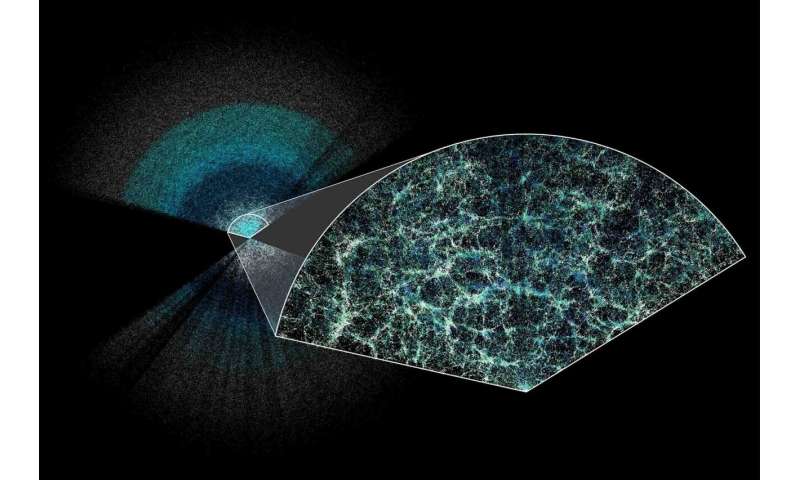New findings reveal clearer picture of expanding universe

An astrophysicist from The University of Texas at Dallas and his colleagues from the Dark Energy Spectroscopic Instrument (DESI) collaboration are at the forefront of an ambitious experiment to study the expansion of the universe and its acceleration.
Dr. Mustapha Ishak-Boushaki, professor of physics in the School of Natural Sciences and Mathematics (NSM) at UT Dallas, is a member of the DESI collaboration, an international group of more than 900 researchers from over 70 institutions around the world engaged in a multiyear experiment to increase understanding of the history and fate of the cosmos.
On April 4, Ishak-Boushaki presented analyses of the first year of data collected by the DESI experiment at a meeting of the American Physical Society in Sacramento, California, along with two other DESI scientists. Ishak-Boushaki presented the cosmology results inferred from DESI data and their implications for the universe. Researchers also shared results from the first year of collected data in multiple papers posted on the preprint site arXiv.
The DESI instrument, located at Kitt Peak National Observatory (KPNO) in Arizona, gathers light from the most distant parts of the universe, which enables scientists to map the cosmos as it was in its youth and trace its evolution to what is observed today. Understanding how the universe has evolved is tied to how it ends and to one of the biggest mysteries in physics: What is behind the observation that the expansion of the universe is accelerating?
The analysis of DESI's first year of data collection confirmed the basics of what scientists hold as the best model of the universe, but it also hints that there is more to learn about the underlying cause, or causes, of cosmic acceleration, the discovery of which led to the Nobel Prize in physics in 2011.
Cosmic acceleration is problematic because it counters how gravity, which causes objects with mass to be drawn together, is observed to work in our solar system and nearby space.
"Gravity pulls matter together, so that when we throw a ball in the air, the Earth's gravity pulls it down toward the planet," Ishak-Boushaki said. "But at the largest scales, the universe acts differently. It's acting like there is something repulsive pushing the universe apart and accelerating its expansion. This is a big mystery, and we are investigating it on several fronts. Is it an unknown dark energy in the universe, or is it a modification of Albert Einstein's theory of gravity at cosmological scales?"
Dark energy is thought by many scientists to play a key role in cosmic acceleration, but it is not well understood. Some theorize that it is a cosmological constant—an intrinsic property of space that drives the acceleration.
To study dark energy's effects over the past 11 billion years, the DESI group has created the largest 3D map of the cosmos ever constructed using the most precise measurements to date. This is the first time that scientists have measured the expansion history of the young universe with a precision better than 1%.
The leading model of the universe is known as Lambda-CDM. It includes both ordinary matter and a rarely interacting type of matter called cold dark matter (CDM) and dark energy, known as Lambda. Both matter and dark energy shape how the universe expands, but in opposing ways. Through gravitational attraction, matter and dark matter slow down the expansion, while dark energy speeds it up. The amount of each influences how the universe evolves. This model is effective at validating results from previous experiments and describing how the universe looks throughout time, Ishak-Boushaki said.
When DESI's first-year results are combined with data from other studies, however, there are some subtle differences from what the Lambda-CDM model would predict.
"Our results show some interesting deviations from the standard model of the universe that could indicate that dark energy is evolving over time," Ishak-Boushaki said. "The more data we collect, the better equipped we will be to determine whether this finding holds. With more data, we might identify different explanations for the result we observe or confirm it. If it persists, such a result will shed some light on what is causing cosmic acceleration and provide a huge step in understanding the evolution of our universe."
More data also will improve DESI's other early results, which weigh in on the Hubble constant—a measure of how fast the universe is expanding today—and the mass of particles called neutrinos.
DESI is the first spectroscopic experiment to perform a fully blinded analysis, which conceals the true result from the scientists to avoid any subconscious confirmation bias. Researchers work "blind" with modified data and write computer code to analyze their findings. Once everything is finalized, they apply their analysis to the original data to reveal the actual answer.
"Dr. Ishak-Boushaki's research and his collaboration with scientists at some 70 institutions is revealing important insights about our universe, and the results are fascinating," said Dr. David Hyndman, dean of NSM and the Francis S. and Maurine G. Johnson Distinguished University Chair. "It's inspiring to have such world-class research programs at UT Dallas and to see our scientists play key roles in fundamental discoveries."
Provided by University of Texas at Dallas